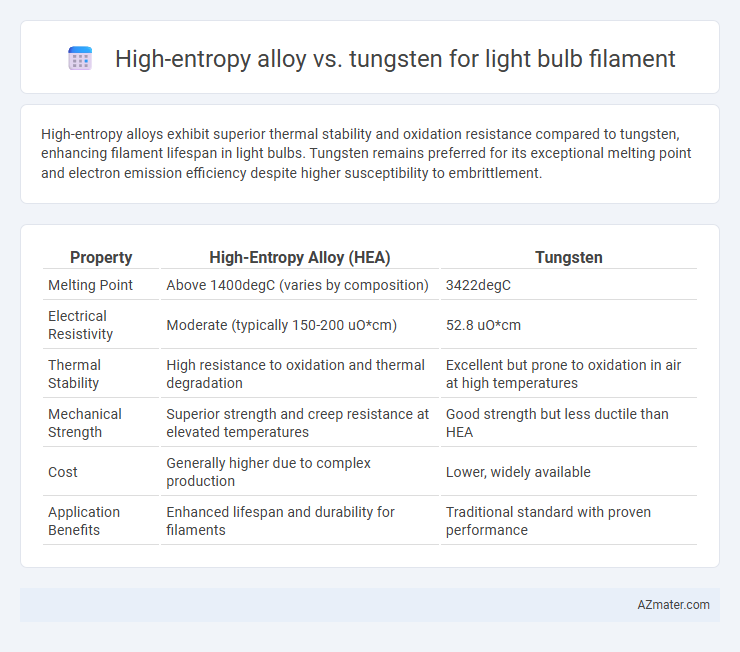High-entropy alloys exhibit superior thermal stability and oxidation resistance compared to tungsten, enhancing filament lifespan in light bulbs. Tungsten remains preferred for its exceptional melting point and electron emission efficiency despite higher susceptibility to embrittlement.
Table of Comparison
| Property | High-Entropy Alloy (HEA) | Tungsten |
|---|---|---|
| Melting Point | Above 1400degC (varies by composition) | 3422degC |
| Electrical Resistivity | Moderate (typically 150-200 uO*cm) | 52.8 uO*cm |
| Thermal Stability | High resistance to oxidation and thermal degradation | Excellent but prone to oxidation in air at high temperatures |
| Mechanical Strength | Superior strength and creep resistance at elevated temperatures | Good strength but less ductile than HEA |
| Cost | Generally higher due to complex production | Lower, widely available |
| Application Benefits | Enhanced lifespan and durability for filaments | Traditional standard with proven performance |
Introduction to Light Bulb Filament Materials
High-entropy alloys (HEAs) offer unique microstructural stability and enhanced thermal resistance compared to traditional tungsten filaments used in light bulbs. Tungsten remains the industry standard due to its extremely high melting point of 3422degC and excellent electrical conductivity, which are critical for filament longevity and light output efficiency. Recent research explores HEAs for filament applications aiming to improve oxidation resistance and mechanical strength under high temperatures, potentially extending bulb lifespan and performance beyond tungsten's limitations.
Overview of High-Entropy Alloys (HEAs)
High-entropy alloys (HEAs) are advanced materials composed of five or more principal elements in near-equal atomic percentages, offering exceptional thermal stability and mechanical strength compared to traditional tungsten. These alloys exhibit high melting points, superior oxidation resistance, and improved creep resistance, making them promising candidates for light bulb filaments operating at extreme temperatures. HEAs provide a potential alternative to tungsten by enhancing filament durability and efficiency in high-temperature lighting applications.
Tungsten: The Traditional Filament Material
Tungsten remains the traditional filament material for light bulbs due to its extremely high melting point of 3422degC and excellent thermal stability, which ensures durability and consistent light output under high-temperature conditions. Its superior electrical resistivity and low vapor pressure reduce filament evaporation, contributing to longer filament life compared to other metals. Despite emerging research on high-entropy alloys for enhanced mechanical properties, tungsten's proven reliability and efficiency continue to dominate commercial light bulb manufacturing.
Key Properties of High-Entropy Alloys for Filament Use
High-entropy alloys exhibit superior thermal stability and oxidation resistance compared to tungsten, making them promising candidates for light bulb filaments. Their multi-element composition enhances mechanical strength and reduces filament evaporation rates, resulting in longer lifespan and improved energy efficiency. These key properties address the limitations of tungsten, such as brittleness and rapid degradation at high temperatures.
Comparative Thermal Stability: HEA vs Tungsten
High-entropy alloys (HEAs) demonstrate superior thermal stability compared to tungsten when used as light bulb filaments, maintaining structural integrity at temperatures exceeding 3000 K without significant grain growth or phase transformation. Tungsten, while possessing a high melting point of 3422 degC, often suffers from recrystallization and brittleness under prolonged high-temperature operation, reducing filament lifespan. The multicomponent nature of HEAs allows tailored thermal properties and oxidation resistance, offering enhanced durability and efficiency in filament applications relative to pure tungsten.
Electrical Conductivity Comparison
High-entropy alloys exhibit lower electrical conductivity compared to tungsten, which remains the preferred material for light bulb filaments due to its exceptional electrical resistivity and high melting point. Tungsten's electrical conductivity is optimized to sustain high temperatures and resist oxidation, making it ideal for filament durability and efficiency. Although high-entropy alloys offer promising mechanical properties, their electrical conductivity limitations currently restrict their application in light bulb filaments.
Resistance to Oxidation and Corrosion
High-entropy alloys exhibit superior resistance to oxidation and corrosion compared to tungsten, making them promising candidates for light bulb filaments operating at high temperatures. The multidimensional elemental composition in high-entropy alloys forms stable oxide layers that inhibit degradation, whereas tungsten tends to oxidize rapidly, leading to filament brittleness and failure. Enhanced oxidation resistance of high-entropy alloys contributes to longer filament lifespan and improved performance under harsh operating conditions.
Cost and Manufacturing Considerations
High-entropy alloys offer improved resistance to oxidation and mechanical stability at high temperatures compared to tungsten, but their complex composition leads to higher raw material costs and more intricate manufacturing processes. Tungsten remains the standard filament material due to its high melting point, availability, and well-established production techniques, resulting in lower overall manufacturing expenses. Choosing between high-entropy alloys and tungsten involves balancing enhanced performance against economic feasibility and scalability in filament production.
Performance in Real-World Lighting Applications
High-entropy alloys demonstrate superior performance compared to tungsten in light bulb filaments due to their enhanced thermal stability and resistance to oxidation, resulting in longer service life under high operating temperatures. These alloys maintain consistent luminous efficacy and structural integrity in real-world lighting conditions, reducing filament failure rates and energy consumption. Tungsten filaments, while historically dominant, tend to suffer from rapid evaporation and brittleness, limiting their efficiency and durability in modern lighting applications.
Future Prospects for Filament Technology
High-entropy alloys (HEAs) demonstrate superior thermal stability and oxidation resistance compared to traditional tungsten filaments, presenting promising advancements in filament technology. HEAs' customizable compositions enable enhanced durability and efficiency, potentially extending the lifespan of light bulb filaments under extreme operating conditions. Ongoing research into HEA-based filaments may revolutionize lighting solutions by reducing energy consumption and improving filament performance beyond the limitations of conventional tungsten.

Infographic: High-entropy alloy vs Tungsten for Light Bulb Filament
 azmater.com
azmater.com